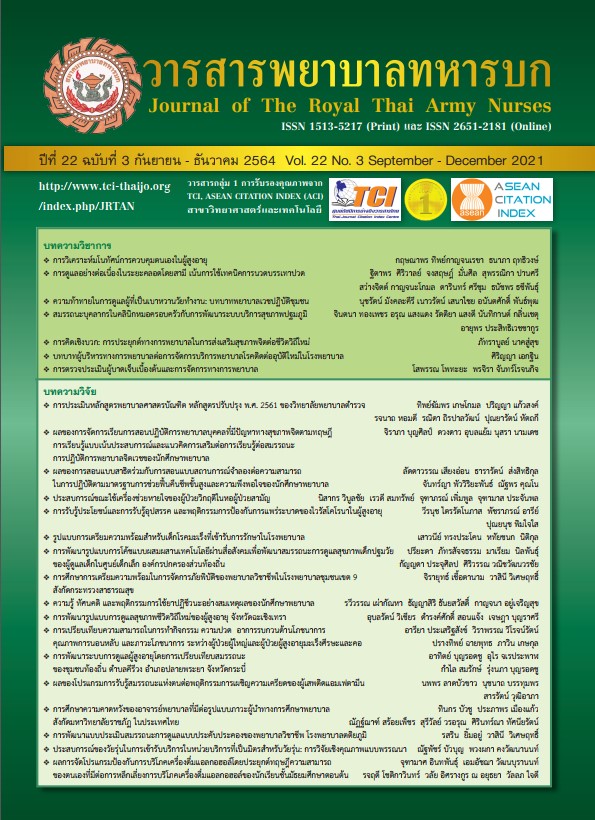Factors Related to Repeat Pregnancy Prevention Behaviors of Postpartum Adolescent Mothers
Keywords:
repeat pregnancy prevention behavior, sexual communication, adolescent mother, factor related to repeat pregnancyAbstract
The objectives of this descriptive correlational research were to study the repeat pregnancy prevention behaviors and the factors related to the behaviors among adolescent mothers. The samples were adolescent mothers who attended the postpartum care units. 130 adolescent mothers were recruited by the convenience sampling method. The personal data record form, the Sexual Communication Behavior Questionnaire and the Repeat Pregnancy Behavior Questionnaire were used for data collection. Content Validity Index (CVI) of questionnaires were 0.93, 0.79 respectively. Cronbach’s alpha coefficients were 0.86, 0.9 respectively. The data were analyzed by using descriptive statistics, Pearson’s product moment correlation coefficient and Point-biserial correlation coefficient. The results revealed that the samples had average total scores of repeat pregnancy prevention behaviors in the medium level (Mean = 49.24, SD = 10.31). Age and family communication about sex factors were positively associated with total repeat pregnancy prevention behaviors at a significant level (r = .221, .327, p < .05 respectively) Nurses should promote family communications about sex could bring about better repeat pregnancy prevention behaviors which would solve repeat pregnancy problems especially in adolescent mothers at early age.
Downloads
References
Kurivilla S, Bustreo F, Kuo T, Mishra, et al. The global strategy for women’s, children’s a n d adolescents’ health (2016-2030): a roadmap based on evidence and country experience. Bull World Health Organization. 2016; 94(5): 398-400.
Bureau of Reproductive Health, Department of Health. Adolescents reproductive health situation report. Nonthaburi: Ministry of Public Health; 2019. (in Thai)
Arayajaru P, Pataipakaipet K, Oumkrua A. Repeat pregnancy among adolescent mothers: therisk factors and the impacts on maternal and child’s health. Journal of Royal Thai Army Nurses. 2019; 20(3): 86-92. (in Thai)
Pungbangkadee R, Ratinthorn A. Factors and consequences of repeat pregnancy among teenagers: a case study in Bangkok Metropolis. Journal of Nursing Science. 2014; 32(2): 23-31. (in Thai)
Talungchit P, Lertbunnaphong T, Russameechareon, K. Prevalence of repeat pregnancy including pregnancy outcome of teenage women. Siriraj Medical Journal. 2017; 69(6): 363-9. (in Thai)
Arethwetch W, Kankarn W. Effectiveness of life assets development to prevent unintended repeat pregnancy behaviors among adolescent maternal. Journal of Nursing and Health Care. 2017; 35(3): 69-77. (in Thai)
Tumchuea S. Sexual behaviors and factors correlated with the intention of protection in teenage pregnancy, Saraburi province. Nursing Journal of the Ministry of Public Health. 2015; 25(1): 97-109. (in Thai)
Huangthong M, Deoisres W, Suppaseemanont W. The factors related to rapid repeat pregnancy among teenage pregnant women. Journal of Phrapokklao Nursing College. 2019; 30(1): 161-72. (in Thai)
Wattanathamrong V, Sirisopon N, Kainakha P, Onsiri S, Amitpie C, Anek A, et al. Factors related intention contraception type implants in repeat pregnancies adolescents. Journal of the Royal Thai Army Nurses. 2017; 18 (Supplement): 102-11. (in Thai)
Ajzen I. The theory of planned behaviour: reactions and reflections. Psychol Health. 2011; 26(9): 1113-27.
Widman L, Choukas-Bradley S, Noar S, Nesi J, Garrett K. Parent-adolescent sexual communication and adolescent safer sex behavior: a meta-analysis. JAMA Pediatrics. 2016; 170(1): 52-61.
Srisuriyawet R, Homsin P. Importance of mothers’ communication with their daughters regarding sex-related risks, mothers’ attitudes towards pre-marital sex and females teenagers’ ability to refuse to have sexual intercourse. Thai Journal of Nursing Council. 2014; 29(3): 31-41. (in Thai)
Pancharern S, Kontha J, Jongkae P. Factors related to the intention to repeat pregnancy among pregnant adolescents. Journal of Social Science and Buddhistic Anthropology. 2020; 5(10): 231-47. (in Thai)
Smith KP. Adolescence: A very short introduction. Oxford: Oxford University Press; 2016.
Tipwareerom W, Jalayondeja C, Hanrungcharotorn. Predicting factors of condom use among high school boys. Journal of Health and Nursing Research. 2020; 36(3): 69-79. (in Thai)
Tipwareerom W, Powwattana A, Lopvongwatana P. Predictors of risky sexual behaviors among adolescent boys, Phisanulok Province. Journal of Public Health Nursing. 2013; 27(1): 31-45. (in Thai)
Hattakitpanichakul K, Phuphaibul R, Phumonsakul S, Viwatwongkasem C. Effectiveness of the Dual Approach Program to promote sexual abstinence in Thai early female adolescents and improve parent-daughter sexual communication. Journal of Health Research. 2019; 33(4): 280-92.
Chareonsuk J, Phuphaibul R, Sinsuksai N, Viwarwongkasem C, Villarruel AM. Development of the casual model of young Thai female adolescents’ sexual abstinence intention. Pacific Rim Int J Nurs Res. 2013; 17(4): 329-41.
Seedaket S, Chotchai T. Health literacy of school-age pregnancy prevention and sexual intercourse among high school students in Khon Kaen Province. Journal of Health and Nursing Research. 2021; 37(1): 99-111. (in Thai)
Butchareon W, Pichayapinyo P, Pawwattana A. Factors related to sexual risk behavior among Thai secondary school students. Journal of Public Health. 2012; 42(1): 30-40. (in Thai)
Somroop A, Deoisres W, Suppaseemanont W. Factors influencing the use of postpartum contraceptive implants among primiparous adolescents. Journal of Faculty of Nursing Burapha University. 2019; 27(3): 79-87. (in Thai)
Downloads
Published
How to Cite
Issue
Section
License
บทความหรือข้อคิดเห็นใดใดที่ปรากฏในวารสารพยาบาลทหารบกเป็นวรรณกรรมของผู้เขียน ซึ่งบรรณาธิการหรือสมาคมพยาบาลทหารบก ไม่จำเป็นต้องเห็นด้วย
บทความที่ได้รับการตีพิมพ์เป็นลิขสิทธิ์ของวารสารพยาบาลทหารบก
The ideas and opinions expressed in the Journal of The Royal Thai Army Nurses are those of the authors and not necessarily those
of the editor or Royal Thai Army Nurses Association.






